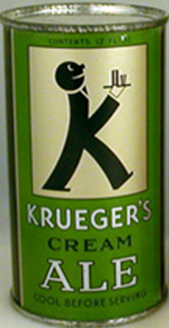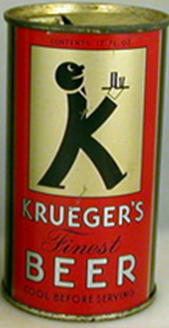Happy Birthday to the beer can! It was 77 years old this past Tuesday-born January 24, 1935. In the late 1920's and early 1930's, the American Can Company really began to experiment with making a can for beer, as they needed to find new avenues for boosting sales. Two major problems stood before them. One was the extreme pressure the carbonated beer put on the seam and lids of the can. Most cans of the day needed to withstand a pressure of 25 to 35 pounds per square inch. A can for beer would need to withstand around 80 pounds PSI, otherwise they would buckle and burst at the seams. The second problem was that beer and metal are natural enemies, and the contact of the beer to the metal can would make the beer undrinkable almost immediately. By 1933, American Can had solved the pressure problem and had developed a process of coating the inside of the can with a thin layer of material that kept the beer from direct contact with the inside of the can. This process was called "Keglined." Many of the larger brewers were still not sold so American approached a small second tier brewery in Newark, New Jersey named G. Krueger Brewing Co. American agreed to install the expensive canning equipment for free, and Krueger would only have to pay for it if the new cans were a hit. If not, American would remove the equipment at no charge. A test batch of 2000 cans of Krueger Special Beer were run through the line in 1933 and given to distributors and other VIPs to sample. Over 90% of the people sampled liked the idea and the decision was made to move forward. Krueger was still hesitant to risk it's good name on the venture, so on January 24, 1935 cans of Krueger Finest Beer and Cream Ale were test released to the general public, but not in Krueger's home market. They were released in Richmond , Virginia, hundreds of miles out of Krueger's marketing territory. This was done in case the cans were a failure or if the "Keglining" did not work, Krueger's reputation would not be harmed in its home market. Needless to say, sales of Krueger beer and ale in cans exploded and they began taking market share from major brewers. Other breweries were quick to jump on board, including Pabst, Heileman, Schlitz, and Ballantine. Other can companies jumped in as well, including Continental Can, who came out with a metal bottle called the cone-top. The only major brewer to use the cone-top was Schlitz. The selling point for the cone-top was that it could be filled on existing bottling lines with only minor adjustments, thus eliminating the huge expense of new canning lines. Smaller breweries and ones that were struggling jumped on the cone-top bandwagon, but it was pretty much a thing of the past by the mid to late 1950's. G. Krueger brewing itself was history by 1961, and the beautiful structures were bulldozed in the mid 1980's. However, the beverage can lives on and billions are used across the globe each year, thanks to a small brewery in Newark, New Jersey that was willing to take a chance. By the way, if you have an original Krueger Finest Beer or Cream Ale can in mint shape, it would be worth upwards of $10,000. If you had one of the 2000 Special cans that were tested in 1933, the sky would be the limit. Only a couple are known to exist. Happy Birthday beer can!


